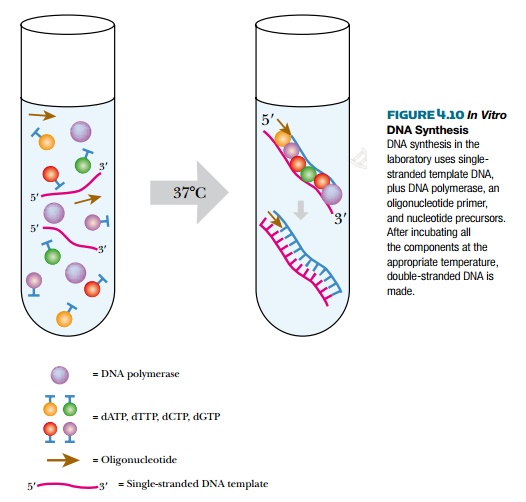Chapter: Biotechnology Applying the Genetic Revolution: DNA Synthesis in Vivo and in Vitro
In Vitro DNA Synthesis
IN
VITRO DNA SYNTHESIS
Making DNA in the laboratory
relies on the same basic principles outlined for replication (Fig. 4.10). DNA
replication needs the following “reagents”: enzymes to open up the double
helix, an RNA primer with a 3′-hydroxyl for DNA polymerase
to extend, and a pool of nucleotide precursors, plus DNA polymerase to catalyze
the addition of new nucleotides.
To perform DNA replication in
the laboratory, a few modifications are made. First, the enzymes that open and
unwind the template DNA are not used. Instead, double-stranded DNA is converted
to single-stranded DNA using heat or a strong base to disrupt the hydrogen
bonds that hold the two strands together. Alternatively, template DNA can be
made by using a virus that packages its DNA in single-stranded form. For
example, M13 is a bacteriophage that infects E. coli, amplifies its genome using rolling circle replication, and
packages the single-stranded DNA in viral particles that are released without
lysing open the E. coli cell. If
template DNA is cloned into the M13 genome, then the template will also be
manufactured as in a single-stranded form. This DNA can be isolated directly
from the viral particles.

In laboratory synthesis of DNA, an RNA primer is not used because RNA is very unstable and degrades easily. Instead, a short single-stranded oligonucleotide of DNA is used as a primer. (As long as the primer has a free 3′-hydroxyl, DNA polymerase will extend either RNA or DNA.) The primers are synthesized chemically (see later discussion) and mixed with the single-stranded template DNA. The oligonucleotide primer has a sequence complementary to a short region on the DNA template. Therefore, at least some sequence information must be known for the template. If the sequence of the template DNA is unknown, it may be cloned into a vector, and the primer is then designed to match sequences of the vector (such as the polylinker region) that are close to the inserted DNA.
Finally, purified DNA
polymerase plus a pool of nucleotides (dATP, dCTP, dGTP, and dTTP) is added to
the primer and template. The primer anneals to its complementary sequence, and
DNA polymerase elongates the primer, creating a new strand of DNA complementary
to the template DNA.
Related Topics